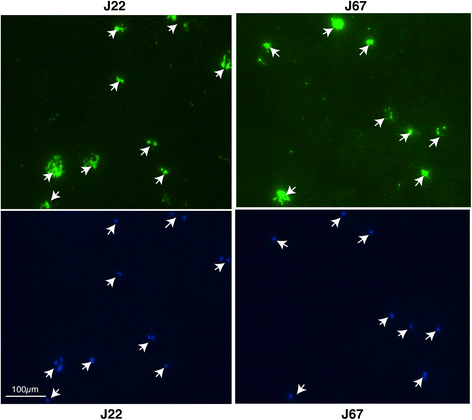A novel quantitative PCR detects Babesia infection in patients not identified by currently available non-nucleic acid amplification tests
- PMID: 28088177
- PMCID: PMC5237571
- DOI: 10.1186/s12866-017-0929-2
A novel quantitative PCR detects Babesia infection in patients not identified by currently available non-nucleic acid amplification tests
Abstract
Background: Ticks transmit Babesia microti, the causative agents of babesiosis in North America and Europe. Babesiosis is now endemic in Northeastern USA and affects people of all ages. Babesia species infect erythrocytes and can be transmitted through blood transfusion. Whole blood and blood products, which are not tested for Babesia, can cause transfusion-transmitted babesiosis (TTB) resulting in severe consequences in the immuno-compromised patients. The purpose of this study was epidemiological evaluation of babesiosis in a tick-infested state.
Results: We examined blood samples from 192 patients who visited clinics during the active tick-borne diseases season, using a newly developed qPCR assay that uses the specific molecular beacon probe. Due to the absence of clear symptomology, clinical laboratories did not test 131 samples by IFA, FISH or microscopic examination of Giemsa-stained blood smears. Babesia infection was detected in all age groups by FISH and microscopy; notably patients >40 years of age represented 64% of tested samples and 13% were younger patients. We tested all samples using qPCR and found that 38% were positive for Babesia. Of 28 samples that were positive by FISH, 27 (96%) were also positive by qPCR indicating high congruency between nucleic acid based tests. Interestingly, of 78 asymptomatic samples not tested by FISH, 22 were positive by our qPCR. Direct detection of Babesia relies upon microscopic examination of patient blood smears, which is labor intensive, difficult to scale up, requires specific expertise and is hence, often not performed. In fact, a clinical laboratory examined only 23 of 86 blood samples obtained from two different counties by microscopy. By considering individuals positive for Babesia infection when results from currently available microscopy, FISH or serological tests were positive, we found that our qPCR is highly sensitive (96.2%) and showed a specificity of 70.5% for Babesia.
Conclusion: Robust qPCR using specific probes can be highly useful for efficient and appropriate diagnosis of babesiosis in patients in conjunction with conventional diagnostics, or as a stand-alone test, especially for donated blood screening. The use of a nucleic acid amplification test based screening of blood and blood products could prevent TTB.
Keywords: Babesia microti; Babesiosis detection; Blood-borne disease; Nucleic acid amplification test; Parasitic disease; Quantitative PCR; Tick-borne infection.
Figures



References
-
- Skotarczak B, Rymaszewska A, Wodecka B, Sawczuk M. Molecular evidence of coinfection of Borrelia burgdorferi sensu lato, human granulocytic ehrlichiosis agent, and Babesia microti in ticks from northwestern Poland. J Parasitol. 2003;89(1):194–196. doi: 10.1645/0022-3395(2003)089[0194:MEOCOB]2.0.CO;2. - DOI - PubMed
-
- Hersh MH, Ostfeld RS, McHenry DJ, Tibbetts M, Brunner JL, Killilea ME, LoGiudice K, Schmidt KA, Keesing F. Co-infection of blacklegged ticks with Babesia microti and Borrelia burgdorferi is higher than expected and acquired from small mammal hosts. PLoS One. 2014;9(6):e99348. doi: 10.1371/journal.pone.0099348. - DOI - PMC - PubMed
Publication types
MeSH terms
Substances
LinkOut - more resources
Full Text Sources
Other Literature Sources

